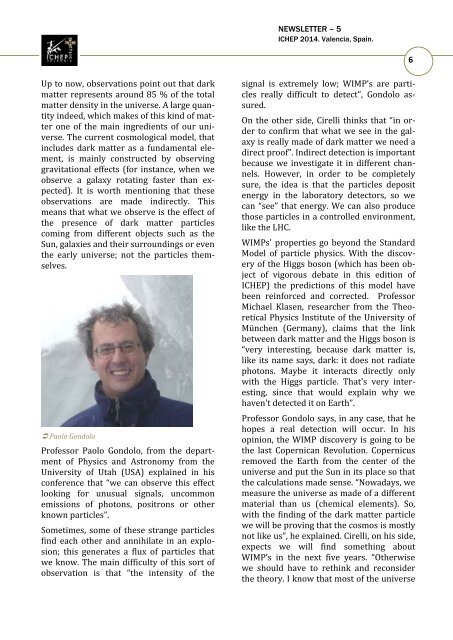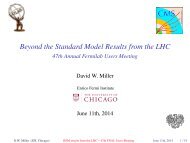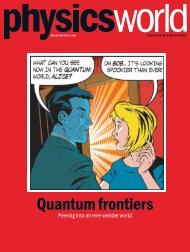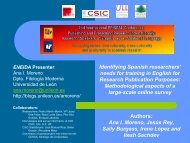yTM9n
yTM9n
yTM9n
You also want an ePaper? Increase the reach of your titles
YUMPU automatically turns print PDFs into web optimized ePapers that Google loves.
NEWSLETTER – 5<br />
ICHEP 2014. Valencia, Spain.<br />
6<br />
Up to now, observations point out that dark<br />
matter represents around 85 % of the total<br />
matter density in the universe. A large quantity<br />
indeed, which makes of this kind of matter<br />
one of the main ingredients of our universe.<br />
The current cosmological model, that<br />
includes dark matter as a fundamental element,<br />
is mainly constructed by observing<br />
gravitational effects (for instance, when we<br />
observe a galaxy rotating faster than expected).<br />
It is worth mentioning that these<br />
observations are made indirectly. This<br />
means that what we observe is the effect of<br />
the presence of dark matter particles<br />
coming from different objects such as the<br />
Sun, galaxies and their surroundings or even<br />
the early universe; not the particles themselves.<br />
Paolo Gondolo<br />
Professor Paolo Gondolo, from the department<br />
of Physics and Astronomy from the<br />
University of Utah (USA) explained in his<br />
conference that “we can observe this effect<br />
looking for unusual signals, uncommon<br />
emissions of photons, positrons or other<br />
known particles”.<br />
Sometimes, some of these strange particles<br />
find each other and annihilate in an explosion;<br />
this generates a flux of particles that<br />
we know. The main difficulty of this sort of<br />
observation is that “the intensity of the<br />
signal is extremely low; WIMP’s are particles<br />
really difficult to detect”, Gondolo assured.<br />
On the other side, Cirelli thinks that “in order<br />
to confirm that what we see in the galaxy<br />
is really made of dark matter we need a<br />
direct proof”. Indirect detection is important<br />
because we investigate it in different channels.<br />
However, in order to be completely<br />
sure, the idea is that the particles deposit<br />
energy in the laboratory detectors, so we<br />
can “see” that energy. We can also produce<br />
those particles in a controlled environment,<br />
like the LHC.<br />
WIMPs' properties go beyond the Standard<br />
Model of particle physics. With the discovery<br />
of the Higgs boson (which has been object<br />
of vigorous debate in this edition of<br />
ICHEP) the predictions of this model have<br />
been reinforced and corrected. Professor<br />
Michael Klasen, researcher from the Theoretical<br />
Physics Institute of the University of<br />
München (Germany), claims that the link<br />
between dark matter and the Higgs boson is<br />
“very interesting, because dark matter is,<br />
like its name says, dark: it does not radiate<br />
photons. Maybe it interacts directly only<br />
with the Higgs particle. That's very interesting,<br />
since that would explain why we<br />
haven't detected it on Earth”.<br />
Professor Gondolo says, in any case, that he<br />
hopes a real detection will occur. In his<br />
opinion, the WIMP discovery is going to be<br />
the last Copernican Revolution. Copernicus<br />
removed the Earth from the center of the<br />
universe and put the Sun in its place so that<br />
the calculations made sense. “Nowadays, we<br />
measure the universe as made of a different<br />
material than us (chemical elements). So,<br />
with the finding of the dark matter particle<br />
we will be proving that the cosmos is mostly<br />
not like us”, he explained. Cirelli, on his side,<br />
expects we will find something about<br />
WIMP’s in the next five years. “Otherwise<br />
we should have to rethink and reconsider<br />
the theory. I know that most of the universe








